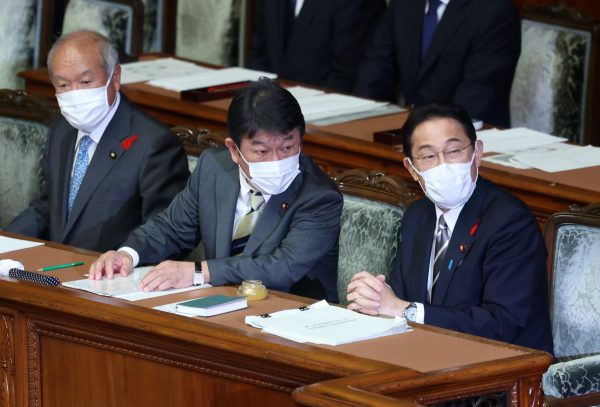Kishida’s first cabinet brought in many new faces, but left in place the ministers in charge of foreign affairs and defence from the previous cabinet. The new government faces escalating foreign policy and ‘intermestic’ challenges — those that cross the barrier between international and domestic — in the coming year that cannot be addressed by perpetuating the status quo, despite the apparent desire among LDP insiders for continuity.
China’s military challenges to Japan and the region are escalating — including around the East and South China Seas and Taiwan, and in broader military competition over China’s growing nuclear arsenal, missile capabilities and new military technologies. In September, Kishida expressed ‘deep alarm’ at Beijing’s aggressive behaviour on the diplomatic and economic fronts. But in his first press conference as Prime Minister on 4 October, he again largely reflected status quo talking points about how Japan must seek to maintain dialogue with China.
Beyond China, Japan also faces a region of mounting security challenges with the North Korea issue and growing military spending among many states raising fears of an arms race over missiles and other advanced weaponry. The new AUKUS agreement between Australia, the United Kingdom and the United States underscores the momentum building for more advanced weapons. Japan will be hard-pressed to keep up at its current rate of defence spending, which is far from the approach that prime minister-hopeful Sanae Takaichi proposed during the LDP leadership contest by calling for Japan to double its defence spending as a percentage of GDP, from the current one per cent to two.
Kishida is often described as more dovish than his rivals, but Japan will probably continue the path begun under former prime minister Shinzo Abe toward modestly increased defence spending, further military capability enhancements and deeper security partnerships with the United States, the Quadrilateral Security Dialogue (Quad) and others. Despite these continuities from the Abe era, Kishida still faces challenges to connect deeply to the Biden administration. He should not take a robust US–Japan connection for granted.
The first-time appointment of a cabinet minister for economic security is one early step in a positive, new direction — as is choosing a younger Diet member for this position, 46-year-old Takayuki Kobayashi. This builds on sustained conversations about the multifaceted China challenge that have been taking place about security concerns that bridge military and economic issues, including cyberattacks, cellular networks and supply chain stability.
Japan’s leadership in trade and other economic engagement also remains a critical component of addressing China’s growing regional influence, and one where Japan has played an especially important role after the US withdrawal from the Trans-Pacific Partnership plan in 2017. China’s recently stated aspiration to join the successor to the Partnership — the Comprehensive and Progressive Agreement for Trans-Pacific Partnership — ahead of Taiwan will require skilful economic diplomacy from Kishida’s team while maintaining Japan’s cooperative but strained relationship with China, Japan’s top trading partner.
Kishida also faces urgent ‘intermestic’ issues. One such challenge in 2022 will be the reopening of Japan after a slow but successful vaccination program that has resulted in Japan becoming one of the most vaccinated countries in the world.
The Indo-Pacific region faces serious challenges to reach high vaccination levels even by late 2022, despite promised assistance by the Quad, China and the World Health Organization’s COVAX program. In the meantime, the Japanese public needs to be encouraged and incentivised to reengage with its regional neighbours, rebuild business and tourist travel and push back against nativist elements that have long posed barriers to a more internationalised Japan (including from within the LDP).
Also bridging the international–domestic policy space is Japan’s continued need to address the serious demographic imbalances that will become even starker in the coming years. Japan must face the stark reality of the growing costs of its rapidly aging population, 28.4 per cent of whom are already aged 65 or higher.
Kishida’s inclusion of his challenger for the LDP presidency, Seiko Noda, in his cabinet as Minister-in-charge of Measures against Declining Birthrate is another bright spot in his early moves as Prime Minister. But after two generations of a below-replacement birth rate, a principal challenge for Kishida’s government will be how to address the consequences of a shrinking population as well as the root cause of the low birth rate. It is difficult to see how this issue can be addressed fully through a domestic lens. Building on small steps by the Abe administration, Kishida’s government should consider further steps toward relaxing Japan’s highly limited immigration policies.
Preparation for the 31 October lower house election will require Kishida to hone his party’s message to voters, seeking to patch up policy disagreements exposed in the four-way LDP leadership race last month. Large swaths of Japanese society appear to lean toward stay-the-course policies reinforced by 18 months of COVID-19-related challenges.
Kishida should resist the temptation to defer bolder action and policy proposals, lest the LDP return to the rotating prime minister pattern of the early 2000s. The United States and other partners require sustained leadership from Japan to help face the mounting challenges ahead.
Andrew Oros is Professor of Political Science and International Studies at Washington College, Maryland, and a Fellow at the Woodrow Wilson International Center for Scholars, Washington DC.

